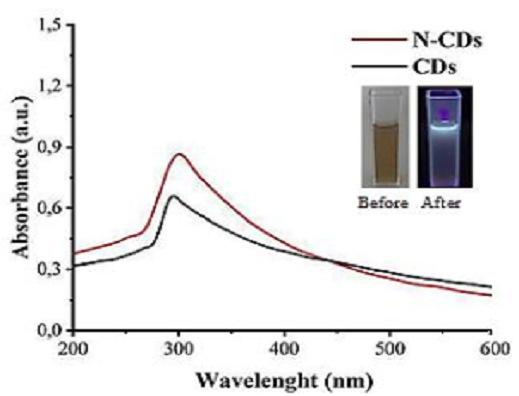Carbon Dots Synthesis from Soybean with Urea Doped As Sensitive Fe(II) Ion Detection
Abstract
Synthesis of carbon dots from soybeans with urea doped (N-CDs) has been successfully conducted using the bottom-up approach via the hydrothermal method. The N-CDs showed a dark brown solution, indicating the carbon dots formed. This study analyzed the effect of optical properties before and after Fe (II) ions addition on the sensitivity of N-CDs. N-CDs characterizations were analyzed using UV-Vis Spectrophotometer and Photoluminescence Spectroscopy (PL). The results showed that the absorbance spectrum range is from 200 to 600 nm, with its absorbance peak at 290 nm. The band gap energy obtained is 3.32 eV, which indicates that N-CDs are semiconductors. The N-CDs solution resulted in good fluorescence when observed under ultraviolet light (395 nm) and emitted a bright green color. N-CDs' sensitivity when sensing Fe (II) ions with a minimum Limit of Detection (LOD) is as low as 5.7 nM. Thus, N-CDs can be used as biosensors with an easy and environmentally friendly method.
Downloads

Copyright (c) 2023 Diana Alemin Barus, Riski Titian Ginting, Anindya Chandra Faizah, Rifa Dwi Shafira, Kevin Nainggolan

This work is licensed under a Creative Commons Attribution-NonCommercial-NoDerivatives 4.0 International License.
Authors who publish with this journal agree to the following terms:
- Copyright on any article is retained by the author(s).
- The author grants the journal, the right of first publication with the work simultaneously licensed under a Creative Commons Attribution License that allows others to share the work with an acknowledgment of the work’s authorship and initial publication in this journal.
- Authors are able to enter into separate, additional contractual arrangements for the non-exclusive distribution of the journal’s published version of the work (e.g., post it to an institutional repository or publish it in a book), with an acknowledgment of its initial publication in this journal.
- Authors are permitted and encouraged to post their work online (e.g., in institutional repositories or on their website) prior to and during the submission process, as it can lead to productive exchanges, as well as earlier and greater citation of published work.
- The article and any associated published material is distributed under the Creative Commons Attribution-NonCommercial-NoDerivatives 4.0 International License.





_copy1.png)










